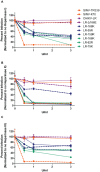Deliberate attenuation of chikungunya virus by adaptation to heparan sulfate-dependent infectivity: a model for rational arboviral vaccine design
- PMID: 24587470
- PMCID: PMC3930508
- DOI: 10.1371/journal.pntd.0002719
Deliberate attenuation of chikungunya virus by adaptation to heparan sulfate-dependent infectivity: a model for rational arboviral vaccine design
Abstract
Mosquito-borne chikungunya virus (CHIKV) is a positive-sense, single-stranded RNA virus from the genus Alphavirus, family Togaviridae, which causes fever, rash and severe persistent polyarthralgia in humans. Since there are currently no FDA licensed vaccines or antiviral therapies for CHIKV, the development of vaccine candidates is of critical importance. Historically, live-attenuated vaccines (LAVs) for protection against arthropod-borne viruses have been created by blind cell culture passage leading to attenuation of disease, while maintaining immunogenicity. Attenuation may occur via multiple mechanisms. However, all examined arbovirus LAVs have in common the acquisition of positively charged amino acid substitutions in cell-surface attachment proteins that render virus infection partially dependent upon heparan sulfate (HS), a ubiquitously expressed sulfated polysaccharide, and appear to attenuate by retarding dissemination of virus particles in vivo. We previously reported that, like other wild-type Old World alphaviruses, CHIKV strain, La Réunion, (CHIKV-LR), does not depend upon HS for infectivity. To deliberately identify CHIKV attachment protein mutations that could be combined with other attenuating processes in a LAV candidate, we passaged CHIKV-LR on evolutionarily divergent cell-types. A panel of single amino acid substitutions was identified in the E2 glycoprotein of passaged virus populations that were predicted to increase electrostatic potential. Each of these substitutions was made in the CHIKV-LR cDNA clone and comparisons of the mutant viruses revealed surface exposure of the mutated residue on the spike and sensitivity to competition with the HS analog, heparin, to be primary correlates of attenuation in vivo. Furthermore, we have identified a mutation at E2 position 79 as a promising candidate for inclusion in a CHIKV LAV.
Conflict of interest statement
The authors have declared that no competing interests exist.
Figures









Similar articles
-
A single-amino-acid polymorphism in Chikungunya virus E2 glycoprotein influences glycosaminoglycan utilization.J Virol. 2014 Mar;88(5):2385-97. doi: 10.1128/JVI.03116-13. Epub 2013 Dec 26. J Virol. 2014. PMID: 24371059 Free PMC article.
-
Attenuation of Chikungunya virus vaccine strain 181/clone 25 is determined by two amino acid substitutions in the E2 envelope glycoprotein.J Virol. 2012 Jun;86(11):6084-96. doi: 10.1128/JVI.06449-11. Epub 2012 Mar 28. J Virol. 2012. PMID: 22457519 Free PMC article.
-
Chikungunya Virus Vaccine Candidates with Decreased Mutational Robustness Are Attenuated In Vivo and Have Compromised Transmissibility.J Virol. 2019 Aug 28;93(18):e00775-19. doi: 10.1128/JVI.00775-19. Print 2019 Sep 15. J Virol. 2019. PMID: 31270226 Free PMC article.
-
Molecular epidemiology, evolution and phylogeny of Chikungunya virus: An updating review.Infect Genet Evol. 2016 Jul;41:270-278. doi: 10.1016/j.meegid.2016.04.006. Epub 2016 Apr 13. Infect Genet Evol. 2016. PMID: 27085290 Review.
-
Development of Vaccines for Chikungunya Fever.J Infect Dis. 2016 Dec 15;214(suppl 5):S488-S496. doi: 10.1093/infdis/jiw271. J Infect Dis. 2016. PMID: 27920179 Free PMC article. Review.
Cited by
-
Antagonism of the Sodium-Potassium ATPase Impairs Chikungunya Virus Infection.mBio. 2016 May 24;7(3):e00693-16. doi: 10.1128/mBio.00693-16. mBio. 2016. PMID: 27222471 Free PMC article.
-
SARS-CoV-2 growth, furin-cleavage-site adaptation and neutralization using serum from acutely infected hospitalized COVID-19 patients.J Gen Virol. 2020 Nov;101(11):1156-1169. doi: 10.1099/jgv.0.001481. Epub 2020 Aug 21. J Gen Virol. 2020. PMID: 32821033 Free PMC article.
-
Heparan Sulfate Proteoglycans and Viral Attachment: True Receptors or Adaptation Bias?Viruses. 2019 Jul 1;11(7):596. doi: 10.3390/v11070596. Viruses. 2019. PMID: 31266258 Free PMC article. Review.
-
Vaccine and Therapeutic Options To Control Chikungunya Virus.Clin Microbiol Rev. 2017 Dec 13;31(1):e00104-16. doi: 10.1128/CMR.00104-16. Print 2018 Jan. Clin Microbiol Rev. 2017. PMID: 29237708 Free PMC article. Review.
-
Genome-Wide Screening Uncovers the Significance of N-Sulfation of Heparan Sulfate as a Host Cell Factor for Chikungunya Virus Infection.J Virol. 2017 Jun 9;91(13):e00432-17. doi: 10.1128/JVI.00432-17. Print 2017 Jul 1. J Virol. 2017. PMID: 28404855 Free PMC article.
References
-
- Higgs S (2006) The 2005–2006 Chikungunya epidemic in the Indian Ocean. Vector Borne Zoonotic Dis 6: 115–116. - PubMed
-
- Enserink M (2006) Infectious diseases. Massive outbreak draws fresh attention to little-known virus. Science 311: 1085. - PubMed
-
- Powers AM (2011) Genomic evolution and phenotypic distinctions of Chikungunya viruses causing the Indian Ocean outbreak. Exp Biol Med (Maywood) 236: 909–914. - PubMed
-
- Burt FJ, Rolph MS, Rulli NE, Mahalingam S, Heise MT (2012) Chikungunya: a re-emerging virus. Lancet 379: 662–671. - PubMed
Publication types
MeSH terms
Substances
Grants and funding
LinkOut - more resources
Full Text Sources
Other Literature Sources
Medical

